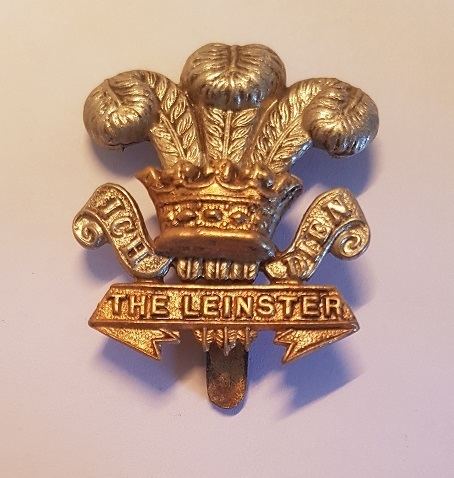Active 1881–1922 Type Infantry Regiment | Role Line Infantry | |
 | ||
Size 2 Regular Battalions3 Militia and Special Reserve Battalions2 Hostilities-only Battalions | ||
The Prince of Wales's Leinster Regiment (Royal Canadians) was an infantry regiment of the line in the British Army, formed in 1881 by the amalgamation of the 100th (Prince of Wales's Royal Canadian) Regiment of Foot and the 109th Regiment of Foot (Bombay Infantry). The 100th Foot was first raised in 1763 and the 109th was first raised in 1761. Between the time of its formation and Irish independence, it was one of eight Irish regiments raised largely in Ireland, its home depot in Birr. It was disbanded with the Partition of Ireland following establishment of the independent Irish Free State in 1922 when the five regiments that had their traditional recruiting grounds in the counties of the new state were disbanded.
Contents
Nineteenth Century
The regiment was formed in 1881 by the amalgamation of the 100th (Prince of Wales's Royal Canadian) Regiment of Foot and the 109th Regiment of Foot (Bombay Infantry). The amalgamation of the two regiments into one with the title Prince of Wales's Leinster Regiment (Royal Canadians), was part of the United Kingdom government's reorganization of the British Army under the Childers Reforms, a continuation of the Cardwell Reforms implemented in 1879.
It was one of eight Irish regiments raised largely in Ireland, with its home depot at Crinkill Barracks in Birr. The regiment recruited mainly in the province of Leinster. Militarily, the whole of Ireland was administered as a separate command within the United Kingdom with Command Headquarters at Parkgate (Phoenix Park) in Dublin, directly under the War Office in London.
The 1st Battalion, which had been in India to Ireland in 1894. A detachment took part in the Fourth Anglo-Ashanti War in 1895, but the rest of the battalion remained in Ireland until moving to Halifax, Canada, in 1898. The 2nd Battalion moved to Ireland in 1882 and to England in 1888. It transferred to Malta in 1894, and joined the Bermuda Garrison the following year. In 1897, it moved to Halifax, and in 1898 to the West Indies.
Second Boer War
Both regular battalions were deployed to South Africa for the Second Boer War. The 1st Battalion saw action around Bethlehem on April 1902 when 14 men were wounded while the 2nd Battalion held the Heilbron branch line in February 1902 when they had 10 casualties. A 3rd Militia Battalion, formed from the former King′s County Militia, was embodied in early 1900 for service in South Africa. They embarked in early March 1900, returning to Ireland after more than two years in late May 1902.
Regular Army
The 1st Battalion, which had been at Faizabad in India, landed at Le Havre as part of the 82nd Brigade in the 27th Division in December 1914 for service on the Western Front but moved to Salonika in December 1915 and then moved to Egypt for service in Palestine in September 1917. The 2nd Battalion landed at Saint-Nazaire as part of the 17th Brigade in the 6th Division in September 1914 for service on the Western Front.
New Armies
The 6th (Service) Battalion landed at Anzac Cove as part of the 29th Brigade in the 10th (Irish) Division in August 1915 but moved to Salonika in September 1915 and on to Egypt for service in Palestine in September 1917 before landing at Marseille in June 1918 for service on the Western Front. The 7th Battalion landed at Le Havre as part of the 47th Brigade in the 16th (Irish) Division in December 1915 for service on the Western Front.
Disbandment
Due to substantial defence cuts and the establishment of the Irish Free State in 1922, it was agreed that the six former Southern Ireland regiments would be disbanded, including the Prince of Wales's Leinster Regiment (Royal Canadians). On 12 June, five regimental colours were laid up in a ceremony at St George's Hall, Windsor Castle in the presence of HM King George V. The six regiments were then all disbanded on 31 July 1922. With the simultaneous outbreak of the Irish Civil War conflict some thousands of their ex-servicemen and officers contributed to expanding the Free State government's newly formed National Army. They brought considerable combat experience with them and by May 1923 comprised 50 per cent of its 53,000 soldiers and 20 per cent of its officers.
In recognition of their Canadian roots, the officers of the 1st Battalion decided to give their officers' mess silver 'in trust' to the Government of Canada "as a token of the regard for the Great Dominion which gave birth to the Battalion to be held in trust until such time as the Battalion is again raised". The silver, known as "The Leinster Plate", was deposited for safe keeping at the Royal Military College of Canada in 1923 at the suggestion of then Minister of National Defence, the Hon. Edward Mortimer Macdonald, and of Major-General James MacBrien, the Canadian Chief of Staff. The silver is on display at Royal Military College of Canada in the Senior Staff Mess and Museum (Fort Frederic).
In 2013 the Regimental Association erected a memorial to commemorate the regiment's strong linkages with the Birr area, particularly to Crinkill Barracks.
Battle honours
The regiment's battle honours were as follows:
Victoria Cross recipients
Colonel-in-Chief
Regimental Colonels
Colonels of the regiment were:
